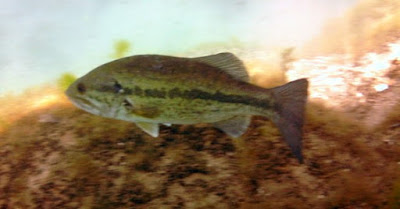Many
people throughout the United States deal with personal issues like depression on
a daily basis. Awareness and the scientific study of mental illnesses has risen
within the past decade. Luckily, there are doctors who can talk patients
through their struggles and, if necessary, prescribe them antidepressant medication
to make their lives as peaceful as possible. Prescribed medications contain
different chemicals that affect the nervous system in many ways. However, medications
such as antidepressants have uncertain effects in the aquatic environment. For
example, the chemical ingredients released from prescribed medications can have
negative effects on fish behavior and their neuro systems.
 |
| Fathead Minnow were prey species in study of predator avoidance by Painter et al. 2009. Photo by Ted Fauceglia. |
In one
study by investigators from the Université de Montréal, it was found when bodies
of water are contaminated and fish are exposed to anti-depressants, they begin
to exhibit a reduction in prey avoidance behavior in Fathead Minnow Pimephales promelas. This is due to the
inhibition of specific neurotransmitters,
such as “…serotonin (5‐hydroxytryptamine; 5‐HT), norepinephrine (NE), and
dopamine (DA)” which are blocked or altered by the contaminant (Painter
et al., 2009). All of these chemical
hormones are crucial to both the central and peripheral nervous system of the
fish. If there are even slight changes in the neurological concentration of the
body from outside sources, it could affect many different intrinsic systems.
One of which is the behavior of complacency toward predator threats.
Antidepressants and prescribed medications cause a panic in the fisheries
science community because many of the ingredients that make up the drugs are
serotonin inhibitors. Serotonin, a neuro hormone found in both human and fish
brain tissue, is used to regulate emotion, sleep cycles, and even the “fight or
flight” response when posed to threats. When antidepressants are introduced
into an ecosystem at a human specific concentration, between 5-40 mg depending
on body size (Phelps 2015), it can completely
destroy the neurotransmitters that the chemicals adhere to due to overload.
This in turn causes the behavioral complacency.
 |
| Venlafaxine affected predator avoidance behaviors of Fathead Minnow (Bisesi et al. 2014). |
Complacency is an issue due to the fact that fish who reside in a watershed
where antidepressants have been introduced may also interact with fish from
other areas who have not. Once in this environment where all other fish have
normal behavior, the changes become apparent. Fish species who have not been altered
by the effects of antidepressants are able to attack and prey upon the newly affected
fish. Due to the destruction of the chemoreceptors in the brain, they begin to lack
fear and swim towards predators. However, these affects also work in the
opposite direction. Fish species who have been affected by the ingredients of antidepressants
have a significantly decreased ability to catch prey and feed. Bisesi et al. (2014) found that bass who were
exposed to venlafaxine, a commonly prescribed
antidepressant, showed increased prey capture time in all 6 of their studies. They
were beginning to capture prey at a much slower rate than if they had not been
affected. Another effect they found to be true was that with the introduction
of venlafaxine, there was a statistically significant reduction in the
serotonin found in brain tissues of fish (Bisesi et al. 2014). Its exposure
to the watersheds has become detrimental to fish neurosystems and behavior. Despite
their hypothesis being proven, they are left with mostly open-ended data. In
their conclusive statement they confer, “Brain
serotonin alone did not adequately explain behavioral results. Serotonin
response in other tissues as well as peripheral effects may have accounted for
additional behavioral responses after brain serotonin reached a depressed
steady state.” (Bisesi et al. 2014), thereby explaining that more
studies must be conducted in the same manner to have conclusive and evidential proof.
Understanding
the behavior of the fish and how these chemicals affect them is extremely
important. However, it is also very important for us to understand how these
chemicals are getting into the environment. If no solution is found to address
this issue, there could be serious declines in fish populations in the future
due to the change in behavior observed in fish that have been exposed to
antidepressants. The chemicals making up these substances are causing fish to
become complacent and not willing to feed or mate. These are serious issues
which need to be addressed in order for fish to live normally. Eliminating
these adverse side effects are critical in order to maintain healthy
ecosystems, maintain species diversity and preserve the sport of fishing. Improved processes more effectively removing these medications and their metabolites from
wastewater are needed to prevent the loss of biological diversity in our lakes
and rivers (Arnnok et al. 2017).
References
Aristotle, and D. M. Balme. 1991.
History of animals. Harvard University Press, Cambridge, MA.
Arnnok, P., R.R. Singh, R. Burakham, A.
Pérez-Fuentetaja, and D.S. Aga. 2017.
Selective uptake and bioaccumulation of antidepressants in fish from
effluent-impacted Niagara River. Environmental Science and Technology
51:10652-10662.
Painter, M. M., M. A. Buerkley, M. L.
Julius, A. M. Vajda, D. O. Norris, L. B. Barber, E. T. Furlong, M. M. Schultz,
and H. L. Schoenfuss. 2009. Antidepressants at environmentally relevant concentrations
affect predator avoidance behavior of larval Fathead Minnows (Pimephales promelas). Environmental Toxicology and Chemistry
28(12):2677.
Phelps, J. 2015. What Is an Adequate
Dose of an Antidepressant?” Psychiatric Times, October 5. Accessed
on 30 April at www.psychiatrictimes.com/depression/what-adequate-dose-antidepressant
Bisesi, J.H., Jr., W. Bridges, and
S.J. Klaine. 2014. Effects of the Antidepressant Venlafaxine on fish brain serotonin
and predation behavior. Aquatic Toxicology 151:88-96. doi:
10.1016/j.aquatox.2014.02.015.




No comments:
Post a Comment